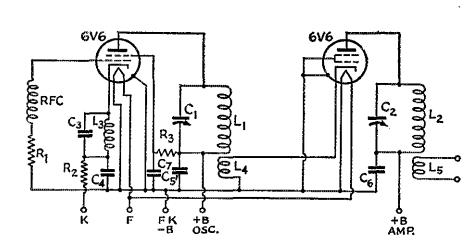Seventy-five years ago this month, QST carried plans for a two-tube “fool-proof rig for 80 and 40 meters.” The author, Don Mix, W1TS, noted that there were two competing factors in coming up with a design: On the one hand, the cost had to be kept low and the circuit be capable of easy construction. But on the other hand, ease of adjustment and operation was important for the beginner. Mix noted that many designs, usually one tube, had erred on the side of low cost, and could prove frustrating for the beginner to operate.
For that reason, Mix settled on this two-tube design using two 6V6’s, or two 6L6’s with a lower plate voltage. One was used as the oscillator with the second serving as final amplifier. This arrangement would keep the keying chirp-free, since the oscillator didn’t need to work at full power. And the final amplifier could be designed in such a way as to prevent parasitic oscillation without the need for the beginner to go through the process of neutralizing the final stage.
The resulting circuit is shown below. The author noted that construction on a metal chassis would be ideal, and took no more time or skill. However, metalwork might require tools not found in the average household, so he showed how to build the set with a wooden chasis, by mounting two 1×2 strips on top. They were spaced such that the sockets for the tubes, coils, and crystal could be mounted between them. The variable condensers could be mounted on the front panel.
He also included a diagram for a suitable power supply which could be built on a similar chassis.
The author was on the ARRL staff, and wrote a number of articles for QST. In 1968, he produced a somewhat updated version of a transmitter for the novice, and that design was later reprinted in “How To Become A Radio Amateur.”
Mix had been on the MacMillian polar expedition in 1923, operating station WNP aboard the Bowdoin. Commander McMillian had recognized the value of radio, but didn’t think that sufficient funds were available. At some point, he had spoken to Hiram Percy Maxim, who suggested that many amateurs would be eager to take part. Mix secured the slot, and operated a station provided by Zenith. On a weekly basis, he transmitted a 500 word press dispatch, handled other traffic, and transmitted a list of amateur calls heard from the Arctic.
As we recounted earlier, one staton who was able to maintain contact with the Bowdoin is a young Art Collins, 9CXX, of Cedar Rapids, Iowa.
Click Here For Today’s Ripley’s Believe It Or Not Cartoon
![]()


